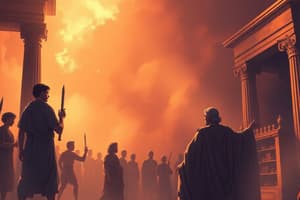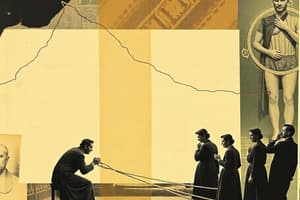Podcast
Questions and Answers
What is the origin of the word 'drama'?
What is the origin of the word 'drama'?
- Sanskrit
- Greek (correct)
- Roman
- Latin
The word 'drama' means 'to sing'.
The word 'drama' means 'to sing'.
False (B)
What does the Greek word 'Dran' signify?
What does the Greek word 'Dran' signify?
to do or to act
The Greek word that drama comes from is ______.
The Greek word that drama comes from is ______.
Match the following elements with their definitions:
Match the following elements with their definitions:
What is primarily developed during the rising action of a story?
What is primarily developed during the rising action of a story?
The inciting incident occurs at the beginning of the rising action.
The inciting incident occurs at the beginning of the rising action.
What type of conflict involves a struggle within a character?
What type of conflict involves a struggle within a character?
The introduction of a story is called the ______.
The introduction of a story is called the ______.
Match the type of conflict to its description:
Match the type of conflict to its description:
What is the primary purpose of a plot diagram?
What is the primary purpose of a plot diagram?
A plot diagram is only useful for fictional stories.
A plot diagram is only useful for fictional stories.
What does plot analysis involve?
What does plot analysis involve?
A plot diagram provides a framework for analyzing and understanding written __________.
A plot diagram provides a framework for analyzing and understanding written __________.
Match the components of a plot diagram with their descriptions:
Match the components of a plot diagram with their descriptions:
What part of a story is typically the most exciting and engages the reader?
What part of a story is typically the most exciting and engages the reader?
The falling action occurs before the climax in a story.
The falling action occurs before the climax in a story.
What term describes the conclusion of a story that shows how things turn out for the characters?
What term describes the conclusion of a story that shows how things turn out for the characters?
The sequence of events that occur after the climax is called the __________.
The sequence of events that occur after the climax is called the __________.
Match the terms with their definitions:
Match the terms with their definitions:
What is considered the key aspect of dialogue in a one-act play?
What is considered the key aspect of dialogue in a one-act play?
All dialogues in a one-act play must contribute to the plot.
All dialogues in a one-act play must contribute to the plot.
What quality must each line of dialogue in a one-act play possess?
What quality must each line of dialogue in a one-act play possess?
In a one-act play, dialogues should be concise and full of _______.
In a one-act play, dialogues should be concise and full of _______.
Match the following aspects of dialogue with their descriptions:
Match the following aspects of dialogue with their descriptions:
Which character in a one-act play requires the most development?
Which character in a one-act play requires the most development?
In a one-act play, all characters are equally developed.
In a one-act play, all characters are equally developed.
What is the primary role of the antagonist in a one-act play?
What is the primary role of the antagonist in a one-act play?
In a one-act play, the hero is generally focused on while some _______ characters can also be developed.
In a one-act play, the hero is generally focused on while some _______ characters can also be developed.
Match the character types with their roles in a one-act play:
Match the character types with their roles in a one-act play:
What is the primary way that action is conveyed in a play?
What is the primary way that action is conveyed in a play?
A play contains long descriptions of setting and characters.
A play contains long descriptions of setting and characters.
What basic elements of fiction and plot does a drama contain?
What basic elements of fiction and plot does a drama contain?
In a play, the entire action is told through __________.
In a play, the entire action is told through __________.
Match the following terms with their descriptions related to plays:
Match the following terms with their descriptions related to plays:
Which element of a one-act play refers to the main idea or message conveyed?
Which element of a one-act play refers to the main idea or message conveyed?
Dialogue is considered an essential element of character development in a one-act play.
Dialogue is considered an essential element of character development in a one-act play.
What is the term used to describe the sequence of events that make up the story in a one-act play?
What is the term used to describe the sequence of events that make up the story in a one-act play?
In a one-act play, characters express their thoughts and feelings through ______.
In a one-act play, characters express their thoughts and feelings through ______.
Match each element of a one-act play with its description:
Match each element of a one-act play with its description:
What is a key characteristic of the plot in a one-act play?
What is a key characteristic of the plot in a one-act play?
In a one-act play, there can be multiple significant events throughout the story.
In a one-act play, there can be multiple significant events throughout the story.
What must be determined for the hero at the climax of a one-act play?
What must be determined for the hero at the climax of a one-act play?
In a one-act play, the audience must understand the events through __________.
In a one-act play, the audience must understand the events through __________.
Match the terms related to one-act plays with their descriptions:
Match the terms related to one-act plays with their descriptions:
What is the main focus of a theme in a one-act play?
What is the main focus of a theme in a one-act play?
A clear theme is optional in a one-act play.
A clear theme is optional in a one-act play.
What should the characters and plot do in relation to the theme?
What should the characters and plot do in relation to the theme?
In a one-act play, the mind needs to be clear about the ______.
In a one-act play, the mind needs to be clear about the ______.
Match the elements of a one-act play with their descriptions:
Match the elements of a one-act play with their descriptions:
Flashcards
Dialogue
Dialogue
The conversation between characters in a play.
Stage Directions
Stage Directions
Instructions for actors, directors, and stage crew.
Reading Plays vs. Novels
Reading Plays vs. Novels
Reading a play is different than reading a novel.
Elements of Drama
Elements of Drama
Signup and view all the flashcards
Character and Setting in Plays
Character and Setting in Plays
Signup and view all the flashcards
Exposition
Exposition
Signup and view all the flashcards
Rising Action
Rising Action
Signup and view all the flashcards
Inciting Incident
Inciting Incident
Signup and view all the flashcards
Character vs. Character
Character vs. Character
Signup and view all the flashcards
Character vs. Self
Character vs. Self
Signup and view all the flashcards
Plot Diagram
Plot Diagram
Signup and view all the flashcards
Plot Analysis
Plot Analysis
Signup and view all the flashcards
Climax
Climax
Signup and view all the flashcards
Resolution
Resolution
Signup and view all the flashcards
Falling Action
Falling Action
Signup and view all the flashcards
What is the climax of a story?
What is the climax of a story?
Signup and view all the flashcards
What is the falling action of a story?
What is the falling action of a story?
Signup and view all the flashcards
Economy in Dialogue
Economy in Dialogue
Signup and view all the flashcards
Purposeful Dialogue
Purposeful Dialogue
Signup and view all the flashcards
Concise Dialogue
Concise Dialogue
Signup and view all the flashcards
Relevant Dialogue
Relevant Dialogue
Signup and view all the flashcards
Character-Driven Dialogue
Character-Driven Dialogue
Signup and view all the flashcards
Origin of "Drama"
Origin of "Drama"
Signup and view all the flashcards
Drama is about 'doing'
Drama is about 'doing'
Signup and view all the flashcards
Actions drive drama
Actions drive drama
Signup and view all the flashcards
Drama is dynamic
Drama is dynamic
Signup and view all the flashcards
Drama is Versatile
Drama is Versatile
Signup and view all the flashcards
Theme in a One-Act Play
Theme in a One-Act Play
Signup and view all the flashcards
Theme Unity
Theme Unity
Signup and view all the flashcards
Audience Understanding
Audience Understanding
Signup and view all the flashcards
Playwright's Intent
Playwright's Intent
Signup and view all the flashcards
Theme Relevance
Theme Relevance
Signup and view all the flashcards
Character Development in One-Act Plays
Character Development in One-Act Plays
Signup and view all the flashcards
Hero
Hero
Signup and view all the flashcards
Antagonist
Antagonist
Signup and view all the flashcards
Supporting Characters
Supporting Characters
Signup and view all the flashcards
Supporting Characters in One-Act Plays
Supporting Characters in One-Act Plays
Signup and view all the flashcards
Theme
Theme
Signup and view all the flashcards
Plot
Plot
Signup and view all the flashcards
Character
Character
Signup and view all the flashcards
One Significant Event
One Significant Event
Signup and view all the flashcards
Hero's Triumph or Defeat
Hero's Triumph or Defeat
Signup and view all the flashcards
Inference and Understanding
Inference and Understanding
Signup and view all the flashcards
Condensed Actions
Condensed Actions
Signup and view all the flashcards
Implied Setting and Characters
Implied Setting and Characters
Signup and view all the flashcards
Study Notes
Drama Definition
- Originates from the Greek word "dran"
- Meaning "to do" or "to act"
- The doing/acting element is key to drama
Studying That Suits You
Use AI to generate personalized quizzes and flashcards to suit your learning preferences.




